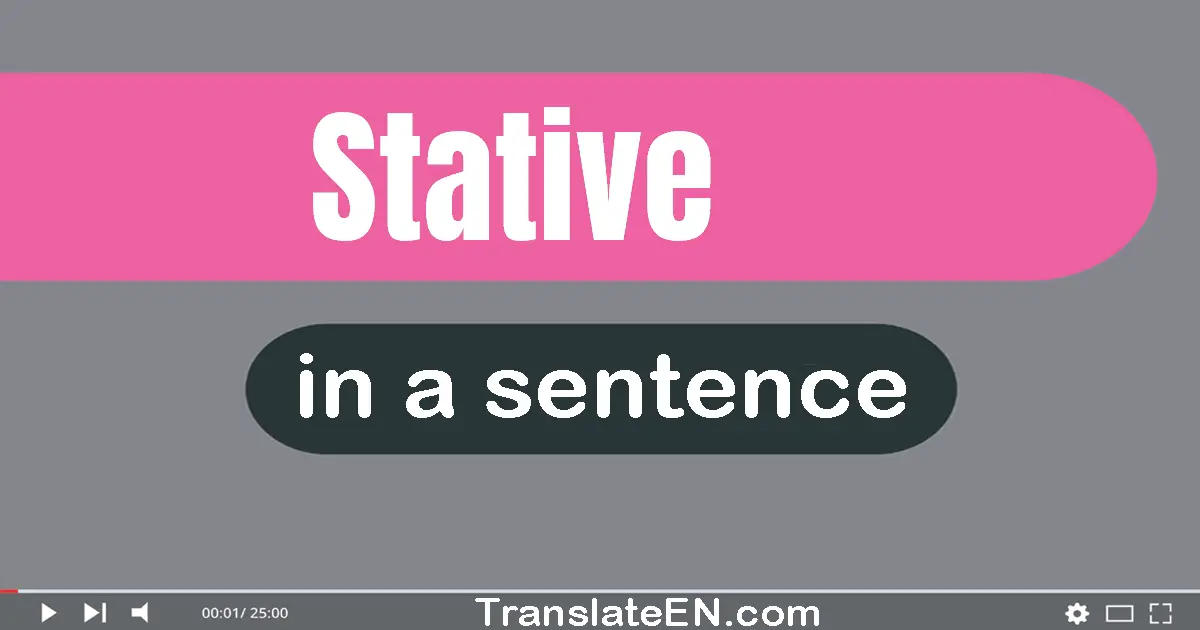Stative in a sentence

(1) The stative verb believe expresses a state of faith.
(2) Stative verbs do not usually have a continuous form.
(3) The stative verb love expresses a state of affection.
(4) The stative verb own indicates a state of possession.
(5) The stative verb remember expresses a state of memory.
(6) She prefers stative verbs to describe states of being.
(7) The stative verb like indicates a state of preference.
(8) The stative adjective happy describes a feeling of joy.
(9) The stative adjective sad describes a feeling of sorrow.
(10) The stative adjective angry describes a feeling of rage.
Stative sentence
(11) The stative verb possess indicates a state of ownership.
(12) Own is a stative verb because it describes a possession.
(13) The stative verb know indicates a state of understanding.
(14) Stative verbs are often used in the present simple tense.
(15) He prefers stative verbs over action verbs in his writing.
(16) She uses stative verbs to describe emotions in her poetry.
(17) The stative adjective nervous describes a feeling of anxiety.
(18) She uses stative verbs to describe permanent characteristics.
(19) Love is a stative verb because it describes a state of being.
(20) The stative adjective tired describes a feeling of exhaustion.
Stative make sentence
(21) The stative adjective calm describes a feeling of tranquility.
(22) Stative verbs are not typically used in the progressive tense.
(23) Believe is a stative verb because it describes a mental state.
(24) The stative verb understand expresses a state of comprehension.
(25) Examples of stative verbs include believe, know, and understand.
(26) Hate is a stative verb because it describes a feeling or emotion.
(27) The stative adjective excited describes a feeling of anticipation.
(28) The stative adjective content describes a feeling of satisfaction.
(29) Stative verbs describe a state or condition rather than an action.
(30) Remember is a stative verb because it describes a mental state or ability.
Sentence of stative
(31) Stative verbs can be used to describe physical states such as feel or seem.
(32) Stative verbs are often used in the present tense to describe ongoing states.
(33) Some stative verbs can also be used as dynamic verbs depending on the context.
(34) Stative verbs can be used to express emotions, thoughts, or physical sensations.
(35) Understanding stative verbs is essential for effective communication in English.
(36) It is important to understand the difference between stative and dynamic verbs in English grammar.
Stative meaning
Stative is an adjective that is commonly used in the field of linguistics to describe a specific type of verb or verb phrase. In this article, we will explore the meaning of stative and provide you with tips on how to use this word or phrase in a sentence effectively.
Firstly, let's understand the definition of stative. Stative verbs, also known as state verbs, are verbs that express a state or condition rather than an action. These verbs describe a state of being, feeling, or possession, and they do not typically indicate an action that can be observed or measured. Examples of stative verbs include "to be," "to like," "to believe," "to own," and "to know." Now, let's delve into some tips on how to use the word "stative" or the phrase "stative verb" in a sentence:
1. Definition: When introducing the concept of stative verbs, you can use the word "stative" to define it.
For example, "A stative verb is a type of verb that describes a state or condition rather than an action."
2. Examples: To illustrate the usage of stative verbs, you can provide examples in your sentence. For instance, "In the sentence 'She knows the answer,' the verb 'knows' is a stative verb as it expresses a state of knowledge."
3. Contrast: You can use the word "stative" to highlight the difference between stative verbs and other types of verbs. For instance, "Unlike dynamic verbs that indicate actions, stative verbs describe states of being or feelings."
4. Sentence construction: When constructing a sentence that includes a stative verb, you can use the phrase "stative verb" to clarify its nature.
For example, "I am feeling tired today" - here, the phrase "am feeling" indicates a stative verb.
5. Grammar explanations: If you are explaining the grammar rules related to stative verbs, you can use the word "stative" to refer to this specific category. For instance, "In English, stative verbs are not typically used in the progressive form."
6. Teaching or learning context: If you are writing an article or giving instructions related to teaching or learning stative verbs, you can use the word "stative" to refer to this topic.
For example, "In order to understand stative verbs better, it is essential to provide students with ample practice exercises."
7. Research or academic context: When discussing stative verbs in a research paper or academic context, you can use the word "stative" to refer to this linguistic phenomenon. For instance, "The study aimed to analyze the usage of stative verbs in different languages."
In conclusion, the word "stative" or the phrase "stative verb" can be effectively used in various contexts, including definitions, examples, contrasts, sentence construction, grammar explanations, teaching or learning contexts, and research or academic contexts. By following these tips, you can confidently incorporate the word or phrase "stative" into your sentences and enhance your linguistic knowledge.
The word usage examples above have been gathered from various sources to reflect current and historical usage of the word Stative. They do not represent the opinions of TranslateEN.com.
